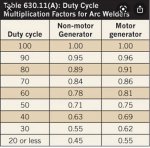Dsg319
Senior Member
- Location
- West Virginia
- Occupation
- Wv Master “lectrician”
Would this be correct in saying this or do I have it wrong. Will post pics of specs from online. But anyhow (non motor)Lincoln 225 arc welder.
It has a rated input current of 50amperes.
Does not list supply conductor size or OCPD. Would it be correct to use 630.11(a).
If that’s the case it would be perfectly fine to supply it with #8awg (60degree) and a 40ampere breaker. Am I doing my math right?
Primary current x multiplier x duty cycle
225 x 45%x 20%= 20.25ampere conductors
It has a rated input current of 50amperes.
Does not list supply conductor size or OCPD. Would it be correct to use 630.11(a).
If that’s the case it would be perfectly fine to supply it with #8awg (60degree) and a 40ampere breaker. Am I doing my math right?
Primary current x multiplier x duty cycle
225 x 45%x 20%= 20.25ampere conductors


